On Wednesday, the Federal Reserve confirmed many analysts’ assumptions that a Fed rate cut (or three) may indeed be on the way. While analysts by and large took the news as a signal of a continued market rally in 2024, not everyone’s in agreement. Would a Fed rate cut be good for stocks? Well, it depends on who you ask.
Indeed, according to Michael Gayed, InvestorPlace contributor and Publisher of the Lead-Lag Report, a Fed rate cut is “bad news for stocks.”
The Chartered Financial Analyst (CFA) believes markets are pricing in a sort of miracle recovery. In his view, analysts have completely and erroneously bought into the “soft landing” narrative — that is, that the central bank will lower rates with perfect timing and avoid any potential economic repercussion of its historically aggressive rate-hike cycle.
Gayed is admittedly skeptical.
Gayed suspects the open dovishness of the Fed is a signal that the central bank has misgivings over the lagging impact of its rate hikes so far. As such, rate cuts may be the Fed’s method of reversing the damage already done:
“[Lowering interest rates] is a double-edged sword. On one hand, it can stimulate economic expansion. On the other hand, it can also lead to inflation and financial instability […] Most importantly, stocks tend to suffer meaningful declines AFTER the Fed begins its pivot. Cutting rates suggests that the Fed overtightened and something likely already broke.”
What Does a Fed Rate Cut Mean for Stocks?
When the Federal Reserve shared their expectations that interest rates would drop as much as 75 basis points in 2024, stocks soared across all major indices. Indeed, the market considered the notion of a Fed rate cut inherently bullish.
Reasonably so, by many traditional standards, when the cost of borrowing goes down, business conditions tend to improve. As Gayed mentions, low interest rates are complicit with stronger economic growth.
However, this ignores the “tail risk” incurred by a such a move. “The term ‘tail risk’ refers to the risk of an investment moving more than three standard deviations from its current price. It represents an event with a small probability but severe potential impact,” Gayed notes.
When considering the current market rally, it’s important to keep things like tail risk and general uncertainty in the markets in mind. Gayed cites China’s hectic economic state and the underperformance of small-cap stocks as evidence that the current optimism in the market may be short-lived.
As Gayed frequently tweets to his more than 700,000 X followers, “path matters more than predictions.”
Analysts Remain Bullish on Dovish Fed
Despite Gayed’s tentativeness, it’s hard to ignore the vast majority of analysts who see the Fed’s recent dovishness as further evidence of a 2024 bull run.
This includes InvestorPlace’s Luke Lango. According to Lango, the Fed’s recent confirmation of rate cuts to come has nearly locked in a soft landing in 2024.
“With this update, the Fed confirmed that we will very likely get an ultra-rare, ultra-powerful ‘soft landing’ in 2024,” Lango writes.
In his view, in each of the times the U.S. has achieved an economic soft landing, stocks went on to surge. There’s little reason to think this time will be an exception.
The fact is, the case has never been stronger for a soft landing in-progress. Inflation is down more than 60% from its peak, unemployment is still below 4% and consumer spending has proven shockingly resilient to the Fed’s restrictive monetary policy.
Heading into 2024, some firms have even dropped previous forecasts of a Fed-induced recession. That isn’t to say the country is out of the doghouse yet, but things are looking tentatively good. How good, however, remains to be seen.
On the date of publication, Shrey Dua did not hold (either directly or indirectly) any positions in the securities mentioned in this article. The opinions expressed in this article are those of the writer, subject to the InvestorPlace.com Publishing Guidelines.

